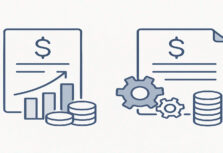December 01, 2025
How Loans Secured By Future Profits Work And What Entrepreneurs Should Know

Loans Secured By Future Profits: How It Works
For decades, the foundation of lending has been collateral—land, property, equipment, or inventory. Banks and financial institutions preferred what they could see and seize in case of non-payment. But modern economies run differently. Many businesses, especially in digital sectors, depend more on predictable revenue streams than on physical assets. To respond to this shift, a new financing approach has emerged: loans secured by future profits. Instead of tying repayment to tangible property, companies pledge their projected income. This model opens credit access for firms that once struggled to qualify for traditional loans. But like every form of borrowing, it has both opportunities and risks that deserve close examination.
Why Future-Profit Loans Emerged
Future-profit lending emerged as business models evolved away from heavy, asset-based structures. Startups, SaaS providers, and service firms often generate recurring revenue without owning significant tangible property. Traditional credit systems failed to accommodate them, leaving entrepreneurs dependent on equity investors or high-interest short-term credit. Lenders began to recognize that steady and predictable cash flow could provide a form of security, even if no physical asset was available. Thus, the idea of using projected profits as collateral gained momentum. By monetizing expected income, businesses could secure financing that matched their structure, while lenders accessed new markets filled with promising but asset-light companies.
The Economic Shift Toward Intangible Value
The rise of technology and service-based enterprises accelerated this trend. Intellectual property, subscriptions, and digital platforms generate value that is hard to mortgage in traditional terms. However, future earnings from these assets are real and measurable. Recognizing this, lenders began shifting their evaluation from balance sheets filled with buildings to forecasts filled with monthly recurring revenue and long-term contracts.
The Pressure On Traditional Lending
At the same time, conventional lenders faced pressure to remain relevant. Asset-light companies formed an increasing share of the economy. Ignoring them meant missing lucrative opportunities. By embracing future-profit loans, lenders adapted to market realities, ensuring they could serve the next generation of businesses without abandoning risk management.
How Loans Secured By Future Profits Work
The structure of these loans differs from asset-backed lending. Instead of presenting deeds or inventory lists, a company provides evidence of projected income. Lenders evaluate historical revenue, customer contracts, and industry growth rates to predict future cash flow. Based on these projections, the lender offers financing, usually tied to a percentage of expected profits. Repayment often scales with performance. During high-revenue months, repayments rise, while in slower months, they fall. This dynamic approach makes debt service less rigid and more aligned with actual operations. Borrowers gain flexibility, and lenders gain exposure to innovative businesses that traditional models might reject.
Revenue-Based Repayment Structures
Many of these loans operate on a revenue-share basis. Instead of fixed installments, the borrower commits to paying a fixed percentage of sales or profits until the loan is repaid. This structure ensures that debt never exceeds the company’s ability to pay, creating resilience during downturns while allowing acceleration in prosperous periods.
Alignment Of Interests
Because repayment depends on performance, lenders are more invested in the success of the business. Some even provide advisory support, marketing assistance, or strategic guidance, knowing that their returns increase as the company grows. This alignment contrasts with traditional loans, where banks remain indifferent as long as payments arrive on schedule.

Businesses Best Suited For Profit-Based Loans
Not every company qualifies for loans based on future profits. Lenders prefer firms with consistent and predictable revenue streams. Subscription-based businesses, software-as-a-service providers, and service companies with long-term contracts fit well into the model. Their earnings can be forecast with reasonable accuracy, reducing lender risk. Retailers with stable seasonal cycles or farms with reliable crop patterns may also benefit. By contrast, businesses with erratic or highly volatile income, such as speculative ventures, may find it difficult to qualify. Lenders require confidence that the projected income is more than optimistic forecasting—it must reflect genuine patterns and market demand.
Subscription Models And Predictability
Companies built on recurring subscription payments illustrate the strength of this lending method. Predictable monthly income provides lenders with a reliable base for calculations. This makes financing accessible even without property or equipment as collateral, unlocking opportunities for rapid scaling.
Contract-Based Service Firms
Professional service firms with long-term contracts also benefit. Consulting agencies, design studios, and digital marketing firms that sign multi-year agreements with clients can demonstrate predictable future revenues, which lenders treat as quasi-collateral in structuring loan terms.
Advantages Of Loans Secured By Future Profits
The appeal of profit-based lending lies in its flexibility and accessibility. Companies without heavy assets can secure financing without sacrificing equity. Repayments adjust to performance, reducing the risk of default during slow periods. Moreover, lenders have a vested interest in supporting company success, sometimes offering non-financial assistance. These features make profit-based loans especially attractive to startups and fast-growing businesses that cannot yet access traditional credit. For entrepreneurs unwilling to dilute ownership by bringing in investors, this model provides a middle ground—funding without loss of control.
Accessibility For Asset-Light Firms
By removing the need for collateral, profit-based loans open financing channels to companies previously excluded. This democratizes access to credit, especially for digital and service-oriented sectors where physical assets are minimal but income potential is substantial.
Reduced Pressure In Downturns
Unlike fixed repayment schedules, revenue-based repayment adapts to fluctuations. During a slump, payments fall, preserving liquidity. This feature can prevent crises that often occur with rigid debt obligations, allowing firms to survive downturns without default.
Risks And Limitations Of Profit-Based Loans
Despite the benefits, these loans are not without drawbacks. One major risk is overestimating future revenue. Entrepreneurs may present overly optimistic forecasts, leading to commitments that reality cannot sustain. Lenders attempt to mitigate this by discounting projections, but miscalculations still occur. Another limitation is cost. Because risk is higher, lenders often charge higher interest rates or revenue-sharing terms, reducing profitability. Companies may also feel constrained by the knowledge that a portion of every sale goes to repayment, sometimes leading to conservative decision-making that limits innovation. Finally, regulatory uncertainty adds complexity, since frameworks designed for collateral-based lending may not fully address profit-based structures.
The Risk Of Over-Optimism
Startups in particular may fall into the trap of assuming growth rates will always accelerate. When those assumptions fail, repayment burdens can exceed actual capacity, pushing firms into financial stress. Responsible forecasting and conservative modeling are essential safeguards.
Costs And Profit Sacrifice
Although repayment aligns with revenue, the cost of capital is often higher than secured loans. Over time, the share of profits allocated to lenders can feel heavy, especially when margins are thin. Companies must calculate carefully whether the trade-off is worth the growth opportunities.

How Lenders Evaluate Future Profits
Assessing future profits requires more than optimism. Lenders employ detailed analysis, combining historical performance with predictive modeling. They examine customer retention, market growth rates, industry benchmarks, and contractual commitments. Predictive algorithms increasingly play a role, analyzing patterns to forecast with greater accuracy. Lenders also look at leadership quality and operational systems, recognizing that execution matters as much as market potential. Borrowers must therefore maintain clean records, transparent data, and credible forecasts. In this environment, trust and clarity are just as important as numbers.
Data And Predictive Analytics
Advanced analytics allows lenders to see beyond simple financial statements. Tools that evaluate churn rates, lifetime customer value, and competitive positioning inform risk assessments. This approach provides a richer picture of a company’s future capacity to repay.
The Importance Of Transparency
Lenders demand honesty in projections. Any sign of inflated numbers or hidden weaknesses undermines credibility and may disqualify applicants. Companies that openly share both strengths and vulnerabilities often secure better terms, since transparency reduces perceived risk.
Comparisons With Traditional Loans
Profit-based loans differ sharply from traditional collateral-backed credit. In conventional lending, repayment is fixed and independent of performance. In profit-based lending, repayment adjusts dynamically. Traditional loans often carry lower costs but demand hard assets. Profit-based loans carry higher costs but require no collateral. The choice depends on a company’s structure, priorities, and tolerance for variability. Some firms combine both approaches, using asset-backed loans for stability and profit-based loans for growth. Each model has its place, and the decision lies in aligning loan type with business needs and risk profile.
Collateral Versus Cash Flow
Traditional loans rely on physical assets, making them suitable for manufacturers, logistics firms, or asset-heavy industries. Profit-based loans rely on projected income, making them ideal for digital, creative, and service businesses that lack tangible property but have strong revenue streams.
Fixed Versus Flexible Repayment
Fixed installments provide predictability but add rigidity. Flexible repayment provides adaptability but reduces certainty. Businesses must weigh whether they prefer consistency with higher asset risk or variability with income sharing. The right answer depends on strategic goals and cash flow realities.
Future Outlook For Profit-Based Lending
Looking ahead, loans secured by future profits are likely to expand as economies become more digital and service-driven. Advances in data analytics and artificial intelligence will improve lenders’ ability to forecast revenues accurately. Blockchain and fintech platforms may also provide transparent systems to track repayments automatically, increasing trust between lenders and borrowers. At the same time, regulators will refine frameworks to ensure fairness and prevent abuse. For entrepreneurs, this evolution means more options but also greater responsibility. Success will depend not only on securing funding but also on ensuring that projections align with realistic growth paths. Borrowing against the future will always involve risk, but with careful planning, it can provide the leverage needed to transform ambition into achievement.
The Role Of Technology
AI-driven forecasting and real-time revenue monitoring will reduce uncertainty for lenders, enabling more precise loan structures. These tools also empower borrowers to monitor obligations in real time, reducing surprises and improving financial management.
Shifts In Market Perception
As profit-based lending becomes more common, stigma around borrowing without collateral will fade. Instead, it will be viewed as a legitimate tool for growth, particularly in economies where intangible assets dominate. This cultural shift will further integrate profit-based loans into mainstream financing.
The Conclusion
Loans secured by future profits mark a fundamental change in business financing. They open credit access to firms with predictable income but little collateral, aligning repayment with actual performance. Their flexibility makes them powerful growth tools, especially for startups and service businesses. Yet they come with costs, risks, and regulatory uncertainties that require careful navigation. Entrepreneurs must approach them with transparency, realistic projections, and discipline. When used responsibly, they transform tomorrow’s income into today’s opportunity, bridging the gap between vision and execution. The challenge lies not in borrowing against the future but in preparing today to ensure that future becomes reality.






